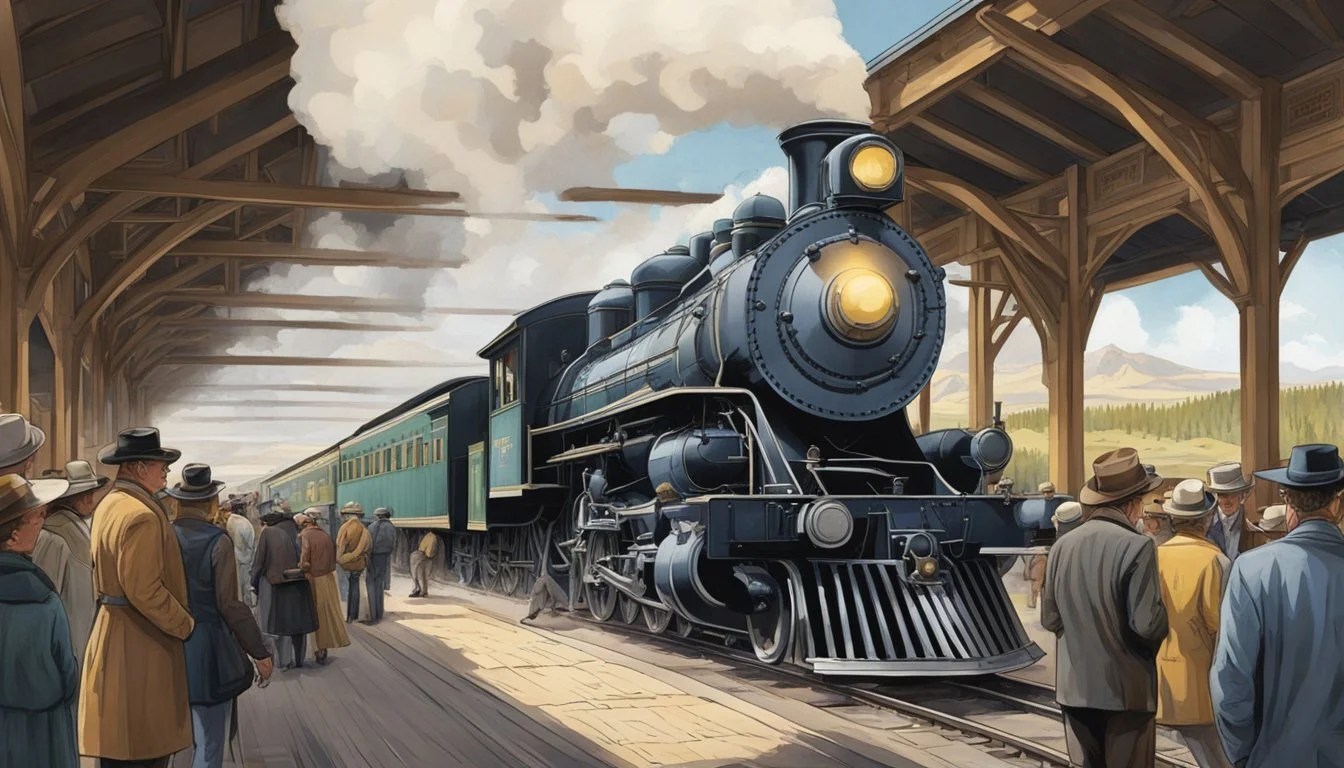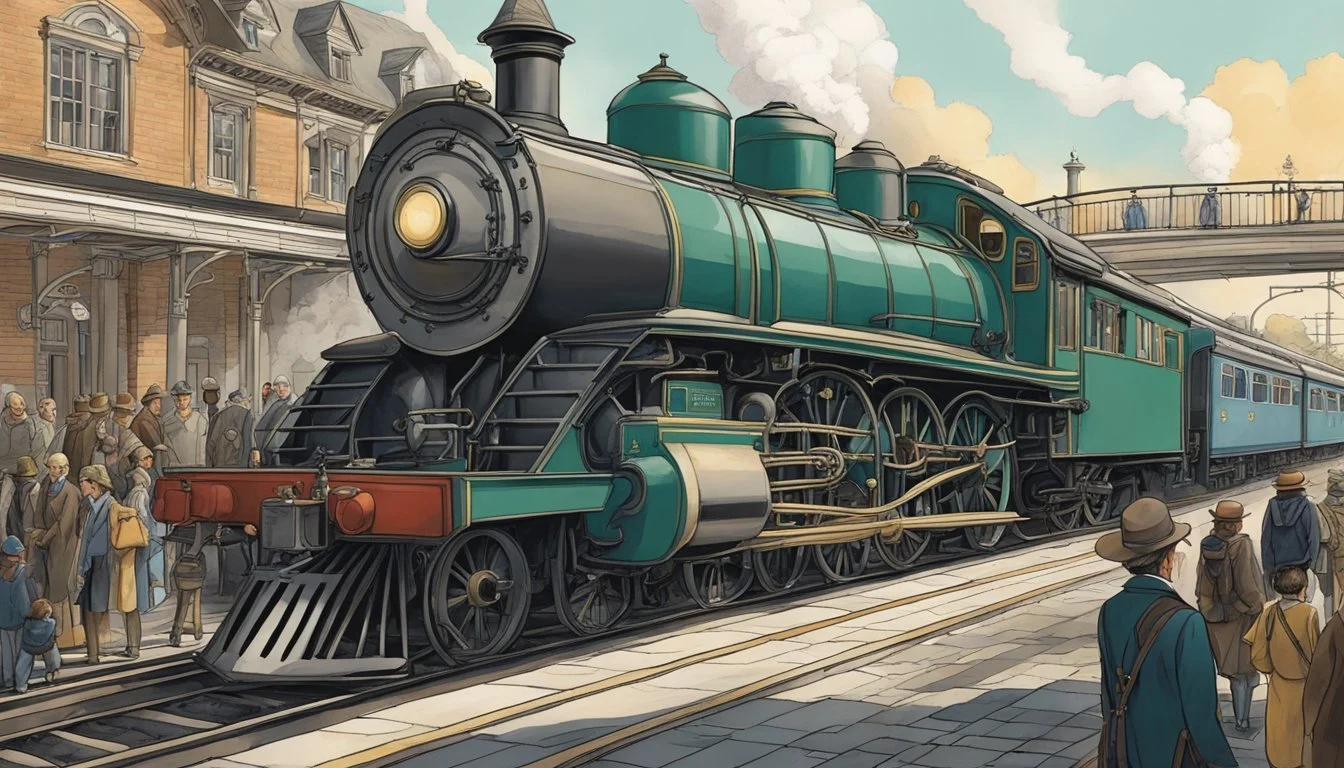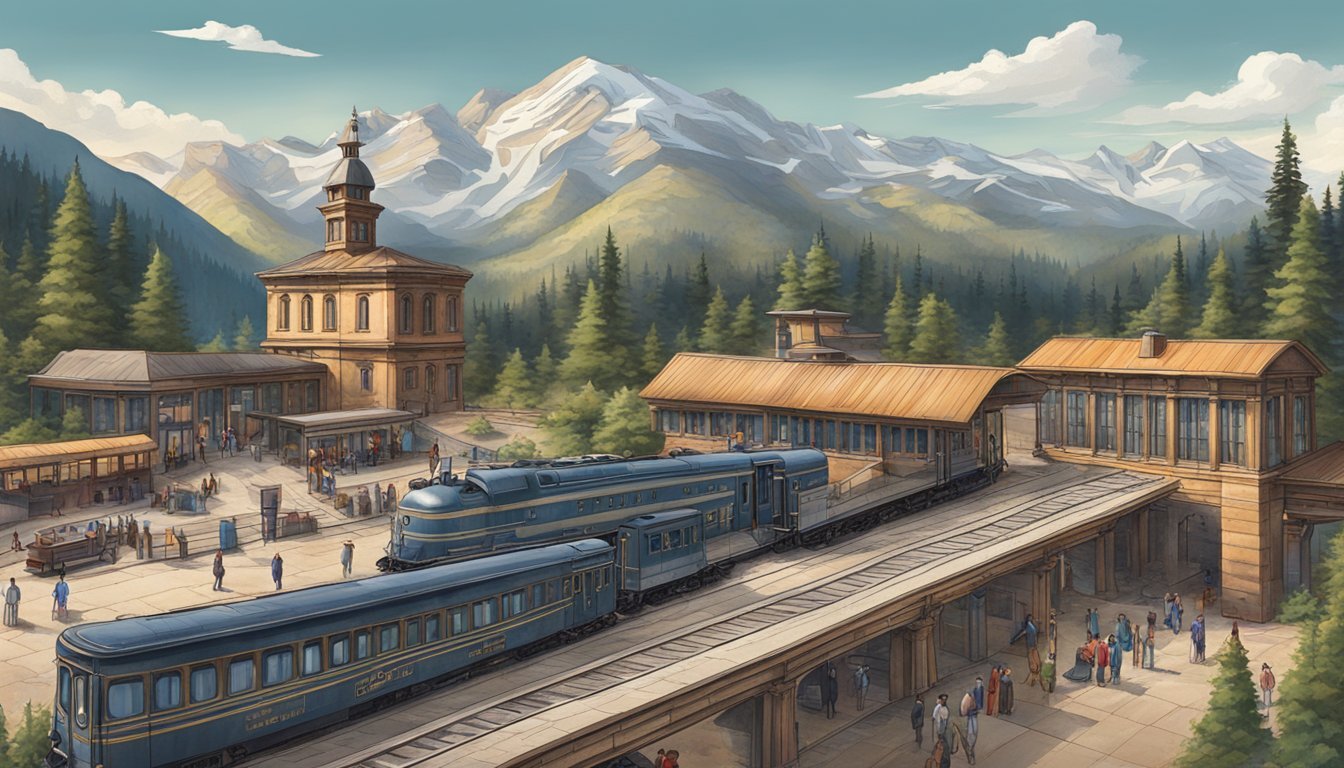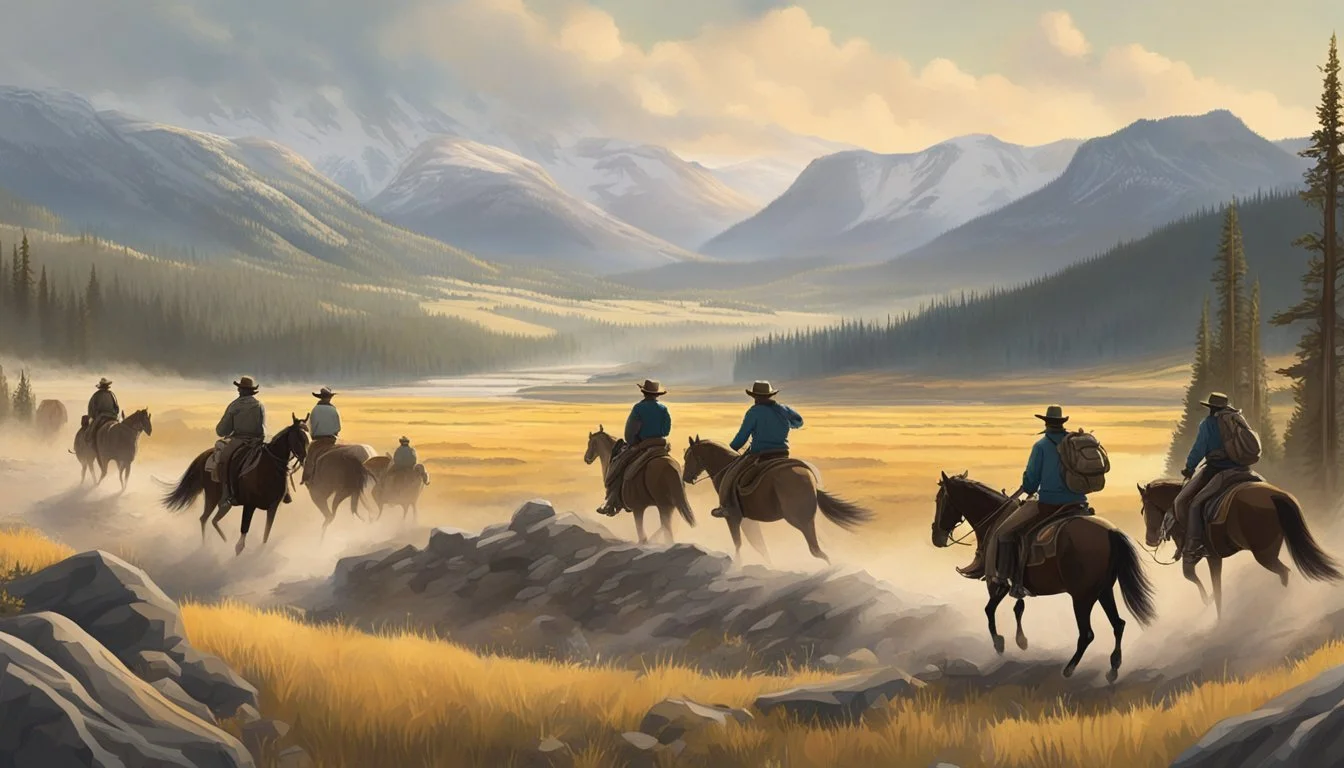Secrets of Yellowstone Train Station Exposed: Duttons' Darkest Deeds Revealed
The "Train Station" in Yellowstone is a chilling location that plays a crucial role in the Dutton family's ruthless tactics. This remote canyon area serves as a secret disposal site for the ranch's enemies and those who know too much about their operations. Located in a lawless region inspired by the real-life "Zone of Death" in Yellowstone National Park, the Train Station provides the Duttons with a convenient way to eliminate threats without legal consequences.
John Dutton himself describes the Train Station as "the trashcan for everyone who's attacked us." This ominous site reflects the show's themes of power, violence, and the lengths the Duttons will go to protect their land and legacy. The Train Station's existence highlights the moral ambiguity of the characters and the harsh realities of their world.
While fictional, the Train Station draws inspiration from an actual area within Yellowstone National Park. This 50-square-mile section in Idaho falls under a complex jurisdiction, creating a legal loophole that has fascinated viewers and sparked discussions about the show's blend of fact and fiction.
Overview of Yellowstone
Yellowstone is a popular American television drama series created by Taylor Sheridan and John Linson. The show premiered in 2018 on the Paramount Network.
Set in Montana, Yellowstone follows the Dutton family, led by patriarch John Dutton (played by Kevin Costner). The Duttons own the largest contiguous ranch in the United States.
The series explores conflicts between the ranch, neighboring Native American reservations, and land developers. It delves into themes of family loyalty, political corruption, and the struggle to preserve a way of life.
Yellowstone's backdrop includes stunning landscapes reminiscent of Yellowstone National Park, though the show is primarily filmed in Utah and Montana. The park itself straddles the borders of Wyoming, Montana, and Idaho.
The show has gained a devoted fan base and critical acclaim for its performances, writing, and cinematography. It has spawned multiple spin-off series, expanding the Yellowstone universe.
Yellowstone's success has revitalized interest in Western-themed entertainment and showcased the rugged beauty of the American West. The series continues to captivate audiences with its blend of modern issues and classic frontier themes.
Train Station Significance
The Train Station in Yellowstone serves as a crucial plot device and symbolic location. It represents the dark underbelly of the Dutton family's power and the lengths they'll go to protect their interests.
Symbolism and Themes
The Train Station embodies the show's themes of justice, power, and moral ambiguity. It's a metaphor for the Duttons' ability to make problems "disappear." The long black train that occasionally passes by reinforces the ominous nature of this location.
This remote site symbolizes the fine line between law and lawlessness that the characters often straddle. It highlights the moral compromises made in the name of survival and family legacy.
Key Plot Points
Several significant events in Yellowstone revolve around the Train Station. It's used to dispose of dead bodies, effectively erasing evidence of murders and other crimes committed by the Duttons and their associates.
The existence of this secret location creates tension and leverage in various storylines. Characters who know about the Train Station hold power over others. Its use often marks turning points in the narrative, showcasing the escalation of conflicts and the depths of character motivations.
The Train Station's inspiration from the real-life "Zone of Death" adds an extra layer of intrigue to its role in the show.
Dutton Family Dynamics
The Duttons navigate complex relationships and power dynamics as they fight to protect their ranch and legacy. Each family member plays a distinct role in shaping the fate of the Yellowstone Dutton Ranch.
John Dutton's Leadership
John Dutton stands as the patriarch and driving force behind the Dutton empire. His unwavering commitment to preserving the ranch shapes every decision he makes. John's leadership style blends ruthlessness with a deep sense of duty to the land and his family.
He often employs unconventional methods to protect his interests, including the use of the "Train Station" to dispose of threats. John's influence extends beyond the ranch, reaching into local politics and business circles.
His children both admire and struggle against his iron grip on the family legacy.
Beth's Ferocity and Strategy
Beth Dutton emerges as a formidable force within the family, known for her sharp intellect and cutthroat tactics. Her loyalty to her father and the ranch is unquestionable, often putting her at odds with external forces and even her own brothers.
Beth's strategic mind proves invaluable in corporate battles and land disputes. She fearlessly confronts the family's enemies, using her business acumen and ruthless determination to outmaneuver opponents.
Her complex relationship with Rip Wheeler adds depth to her character, revealing a softer side beneath her fierce exterior.
Kayce's Moral Compass
Kayce Dutton represents a bridge between the Dutton way of life and the outside world. His military background and connection to his Native American wife's culture often put him at odds with family decisions.
Despite this, Kayce's loyalty to the Duttons remains strong. He struggles to balance his father's expectations with his own sense of right and wrong.
Kayce's role in ranch operations and local law enforcement positions him uniquely to navigate the family's conflicts with both legal and extralegal means.
Jamie's Conflict of Loyalty
Jamie Dutton's journey is marked by internal struggle and shifting allegiances. His legal expertise makes him a valuable asset to the family, but his desire for personal success often clashes with the Dutton agenda.
Jamie's complicated relationship with his adoptive father, John, and sister Beth creates constant tension. His actions frequently put him at odds with family interests, leading to dramatic confrontations and betrayals.
Jamie's character arc explores themes of identity, belonging, and the cost of ambition within the high-stakes world of the Duttons.
Prominent Characters
The Train Station storyline in Yellowstone involves several key characters who play crucial roles in its dark and secretive operations. Their actions and decisions shape the fate of those who end up at this remote disposal site.
Rip Wheeler
Rip Wheeler is John Dutton's loyal ranch foreman and enforcer. He frequently handles the dirty work at the Train Station, disposing of bodies and threats to the Yellowstone ranch. Rip's unwavering loyalty to the Duttons drives his involvement in these grim tasks.
His efficient and ruthless approach to eliminating problems makes him a feared figure among the ranch's enemies. Rip's complex morality allows him to carry out these actions without hesitation, viewing them as necessary for protecting the Dutton family and their interests.
Walker's Return
Walker, a former ranch hand, narrowly escapes being taken to the Train Station. His return to the Yellowstone ranch creates tension, as he knows too much about their illegal activities. Walker's presence threatens the secrecy surrounding the Train Station operations.
His knowledge puts him in a precarious position, forcing him to navigate a delicate balance between loyalty and self-preservation. Walker's storyline highlights the consequences of crossing the Duttons and the constant threat of ending up at the Train Station.
Garrett Randall's Agenda
Garrett Randall, Jamie Dutton's biological father, becomes entangled in the Train Station storyline. His manipulative nature and agenda against the Dutton family put him at odds with their methods of dealing with threats.
Garrett's actions and influence on Jamie create a dangerous situation that could expose the Train Station's secrets. His storyline explores the lengths to which the Duttons will go to protect their interests and the potential consequences of challenging their power.
Notorious Antagonists
The Yellowstone ranch faces threats from cunning adversaries who challenge the Duttons' power and influence. These antagonists employ various tactics to undermine the family's control over their land and resources.
Wade Morrow's Conflict
Wade Morrow emerges as a formidable opponent to the Dutton family. A former ranch hand with a personal vendetta, Wade clashes with John Dutton over past grievances. His actions directly threaten the Yellowstone ranch's operations and security.
Wade's conflict with the Duttons escalates rapidly, leading to violent confrontations. He employs intimidation tactics and attempts to sabotage the ranch's activities. Wade's knowledge of the Duttons' secrets makes him particularly dangerous.
The tension between Wade and the Duttons reaches a boiling point, resulting in a brutal showdown. This conflict showcases the lengths to which the Duttons will go to protect their interests and eliminate threats.
Roarke Morris's Schemes
Roarke Morris, a slick hedge fund manager, poses a different kind of threat to the Yellowstone ranch. His sophisticated financial maneuvers aim to acquire the Duttons' land for development purposes.
Morris employs legal and economic strategies to pressure the Duttons. He represents Market Equities, a powerful corporation with vast resources at its disposal. Roarke's charm and business acumen make him a formidable opponent.
His schemes involve manipulating local politics and exploiting economic vulnerabilities. Roarke's presence forces the Duttons to adapt their tactics and confront challenges beyond physical confrontations.
Malcolm Beck's Threat
Malcolm Beck, along with his brother Teal, presents a sinister threat to the Dutton empire. As wealthy businessmen with political connections, the Becks use their influence to undermine the Yellowstone ranch.
Malcolm's tactics include blackmail, intimidation, and violence. He targets not only the Duttons but also their allies and business interests. Malcolm's ruthlessness makes him one of the most dangerous adversaries the family faces.
The conflict with Malcolm Beck escalates to extreme levels, involving kidnapping and attempted murder. This storyline highlights the brutal nature of the power struggles in Montana's ranching world.
Legal Entanglements
The "Train Station" in Yellowstone intersects with complex legal issues rooted in constitutional loopholes and land jurisdiction. These legal gray areas create challenges for law enforcement and opportunities for fictional characters to exploit.
Zone of Death & Constitutional Loopholes
The "Zone of Death" is a 50-square-mile area in Yellowstone National Park where legal jurisdiction becomes murky. This real-life constitutional loophole inspired the show's "Train Station" concept.
The Sixth Amendment requires juries to be drawn from the state and district where a crime occurred. In this zone, it's impossible to form a constitutionally valid jury, potentially allowing federal crimes to go unpunished.
This legal quirk stems from Yellowstone's unique status as federal land spanning multiple states. The Idaho portion of the park lacks permanent residents, making jury selection impossible.
Land Rights and Legal Battles
The Dutton family's struggle to maintain their ranch highlights real-world conflicts over land rights in the American West.
Federal vs. state jurisdiction often complicates legal matters in areas like Yellowstone. This tension plays out in the show through battles over land use, water rights, and development.
Native American land claims add another layer of complexity. Historical treaties and ongoing legal disputes inform the show's portrayal of conflicts between ranchers and tribal interests.
Conservation laws and regulations also factor into legal battles surrounding Yellowstone. The balance between preserving natural resources and allowing economic development creates ongoing legal challenges for landowners and government agencies.
Cultural and Historical References
The Train Station in Yellowstone draws on Western frontier mythology while blending fiction with real legal and geographical quirks. It taps into themes of vigilante justice and lawlessness associated with the American West.
Western Heritage in Yellowstone
Yellowstone's Train Station embodies the rugged individualism of the Old West. It represents a modern take on frontier justice, where characters dispense their own brand of law enforcement outside official channels. This reflects historical vigilante groups that operated in remote Western territories. The show's creators use this fictional location to explore moral gray areas and the complex history of the American West.
The Train Station also evokes the isolation and untamed nature of the frontier. Its remote setting in a canyon echoes how geography shaped Western culture and law enforcement challenges in sparsely populated areas.
Historical Accuracy and Artistic License
While the Train Station is fictional, it draws inspiration from a real legal anomaly. Legal scholar Brian C. Kalt of Michigan State University identified a "Zone of Death" in Yellowstone National Park. This 50-square-mile area in Idaho faces jurisdictional issues due to constitutional quirks and overlapping state boundaries.
The show takes artistic license with this concept. It exaggerates the legal loophole for dramatic effect, turning it into a consequence-free killing ground. In reality, the federal government maintains jurisdiction over the entire park.
Yellowstone blends fact and fiction to create a compelling narrative device. The Train Station symbolizes the tension between lawlessness and order that defined the historical American West.
Seasonal Developments
The Train Station has played a crucial role across multiple seasons of Yellowstone, evolving in its significance and impact on the characters. Its usage and importance have shifted as the series progressed.
Highlights of Season 1
In Season 1, the Train Station was introduced as a mysterious disposal site for the Dutton family's enemies. John Dutton first revealed its existence to his son Kayce, explaining its purpose as a place where they could get rid of bodies without fear of legal repercussions. The location was used sparingly but effectively, demonstrating the lengths the Duttons would go to protect their ranch and family.
Key events involving the Train Station in Season 1 included:
John taking Kayce there to dispose of a body
Rip using it to eliminate threats to the ranch
The site becoming a symbol of the Duttons' power and ruthlessness
Rising Tensions in Season 5
Season 5 saw an increase in the Train Station's prominence as conflicts escalated. With John Dutton as governor, the stakes became higher, and the need for secrecy more critical. The disposal site became a focal point for several characters, highlighting the moral dilemmas faced by those in the Dutton orbit.
Notable developments:
More frequent visits to the Train Station
Discussions among characters about its necessity and ethics
Increased risk of exposure due to heightened scrutiny on the Duttons
The Train Station's role in Season 5 underscored the growing pressure on the family and their allies.
Anticipation for Yellowstone Season 5 Part 2
As fans await Yellowstone Season 5 Part 2, speculation about the Train Station's future role is rampant. The mid-season finale left several plot threads unresolved, with potential implications for the secretive disposal site.
Expectations for the Train Station in Part 2 include:
Possible discovery by law enforcement or rivals
Internal conflicts among the Duttons regarding its continued use
Flashbacks revealing more about its history and significance
The Train Station remains a dark symbol of the Dutton family's power and the lengths they'll go to maintain it. Its fate in the upcoming episodes could have far-reaching consequences for all involved.
In-Universe Geography
The Train Station's location plays a crucial role in its function within Yellowstone. Its remote setting and proximity to state borders provide a strategic advantage for the Dutton family's covert operations.
Wyoming Border and Rural Landscape
The Train Station is situated near the Wyoming border in a sparsely populated area. This location is strategically chosen for its isolation and lack of witnesses. The rugged terrain features steep cliffs and dense forests, making it an ideal spot for disposing of bodies without detection. The area's remoteness also ensures minimal traffic, reducing the risk of accidental discoveries.
The landscape surrounding the Train Station is characterized by vast open spaces and untamed wilderness. This harsh environment serves as a natural barrier, deterring casual explorers and maintaining the secrecy of the location.
Dutton Ranch as a Central Hub
Dutton Ranch serves as the epicenter of operations related to the Train Station. Its position allows for quick access to the disposal site while maintaining a facade of normalcy. The ranch's expansive property provides cover for suspicious activities and movements.
Key ranch personnel use carefully planned routes to reach the Train Station, avoiding main roads and populated areas. The ranch's resources, including vehicles and equipment, are utilized to facilitate these clandestine trips. This centralized control enables John Dutton to manage the Train Station's usage effectively, ensuring it remains a closely guarded secret.
Cinematography and Soundtrack
"Yellowstone" captivates viewers with its stunning visuals and evocative music. The show's cinematography and soundtrack work in harmony to enhance the storytelling and create a rich, immersive experience.
Visual Storytelling Techniques
"Yellowstone" showcases the breathtaking landscapes of Montana through sweeping aerial shots and panoramic views. The cinematography emphasizes the vast, rugged beauty of the American West, serving as a character in itself.
Close-up shots reveal the actors' subtle expressions, adding depth to their performances. The show's use of natural lighting enhances the authenticity of outdoor scenes, while carefully crafted interior shots reflect the characters' status and personalities.
Dynamic camera movements during action sequences, such as those involving horseback riding or conflicts, heighten tension and excitement. The visual style shifts subtly to match the tone of different storylines, from warm, golden hues for family moments to cooler, bleaker tones for darker themes.
Musical Themes and Motifs
The soundtrack of "Yellowstone" blends country, folk, and western-inspired music to create a distinct sonic identity. Original compositions interweave with carefully selected songs to underscore emotional moments and drive the narrative forward.
Recurring musical motifs are associated with specific characters or plot elements, helping to reinforce themes and character development. The show's theme song sets a powerful, evocative tone that captures the essence of the series.
Songs like "Long Black Train" are strategically placed to enhance pivotal scenes, adding layers of meaning to the visual storytelling. The music often reflects the rugged, independent spirit of the characters and their environment.
Ambient sounds of nature are expertly mixed with the score, immersing viewers in the show's setting and creating a realistic auditory backdrop for the unfolding drama.
Cultural Impact and Fandom
Yellowstone has cultivated a passionate fanbase that engages deeply with the show's characters and storylines. The series has spawned numerous fan theories and discussions, while also expanding into spin-offs and related content.
Fan Theories and Discussions
Viewers eagerly dissect each episode of Yellowstone, crafting elaborate theories about character motivations and future plot developments. Online forums and social media platforms buzz with debates about the Dutton family's fate and the mysterious "Train Station" disposal site.
Fans speculate on potential connections between Yellowstone characters and those in spin-offs like 1923. Some even draw parallels to C.J. Box's Joe Pickett novels, which share similar Western themes.
Spin-offs and Extended Universe
Yellowstone's success has led to an expanding universe of related content. The prequel series 1923, starring Harrison Ford and Helen Mirren, explores the Dutton family's early years in Montana.
1923 season 2 is highly anticipated by fans eager to delve deeper into the Dutton legacy. Additionally, the spin-off 6666 is set to focus on the historic Four Sixes Ranch in Texas, further broadening the Yellowstone universe.
These expansions allow viewers to explore different time periods and locations within the show's richly developed world.






